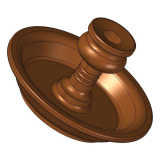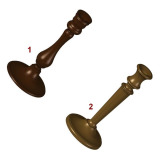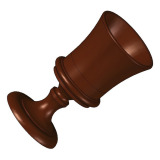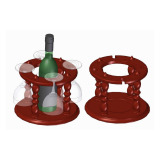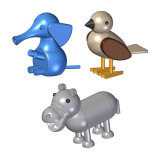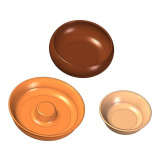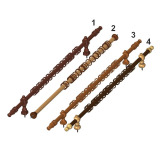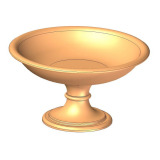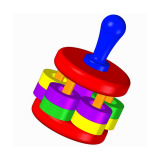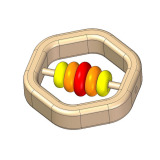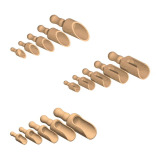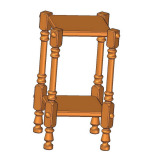In the woodturning projects category we have many free woodturning projects, which are suitable for both hobbyists and professional woodturners.
Choose carefully which of the woodturning project suits your skills. Also note that dimensions of the parts must fit to your lathe. Woodturning is a type of woodworking on the machine called lathe, which rotates a workpiece on its axis, while various operations - such as cutting and sanding with tools - are being performed on that workpiece. This way we manufacture turned wooden parts i.e. the parts which has symmetry about an axis of rotation. In short, lathe spins a workpiece while the woodturner shapes the wood with chisels and gouges.
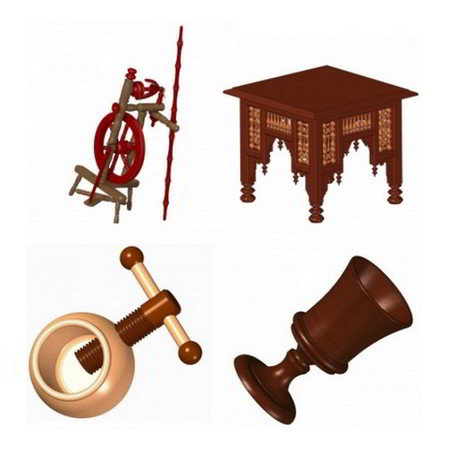
Woodturning is a very old technique that has been known since about 1300 BC in ancient Egypt. In those times, one person would turn the wood with a rope while the other shaped the wood with a sharp tool. The Europeans constantly improved the woodturning technique, but only in the Middle Ages a pedal replaced hand-operated turning. The electrically driven lathe came in use during the Industrial Revolution and has significantly speed up the production and increased the quality of work because of greater rotational speed, and then the mass use of this woodturning technique began. Today, the highly precise computer-operated machinery (CNC) is in use, and it does not require presence of the craftsman. It results in a cheap commercial mass-production, so each hand turned object made by craftsman today represents a unique piece of work that has a special value in the mass-production ambient for the customers who know to appreciate real craftsmanship.
To deal with woodturning you need to own the lathe, lathe cutting tools (chisels, gouges, scraping tools…) lathe accessories (chucks, centers…), measuring and marking tools (calipers, center finder, trammel …) and safety equipment (safety goggles, dust mask…). Woodturning is used to create various wooden objects. It is most commonly used for the manufacture of bowls, furniture parts, toys, boxes and many other useful and beautiful articles in common use. Woodturning is an important technique for each professional, but this technique is also popular with hobbyists, because it can be used to create objects with practical value and the objects with artistic value as well; it does not require big money investment; lathe does not take up much space and the work does not require a large quantity of wood.
- Free and public domain woodturning books
Woodturning can be divided into five basic categories:
- Spindle woodturning - In spindle woodturning, the workpiece is fixed between two points (centers) on a wood lathe and turned on its center axis. With this method the furniture legs, pens and similar objects are being turned.
- Faceplate woodturning – Faceplate turning is turning with the workpiece mounted to a faceplate or in a chuck or jig. Faceplate woodturning method is used for making bowls, vessels, platters and similar objects.
- Eccentric woodturning – Eccentric turning or multi axis woodturning is woodturning technique where workpiece is not concentric with the spindle axis. Workpiece is mounted with a certain axis of rotation, turned, then remounted with a new axis of rotation.
- Spiral woodturning – Spiral woodturning is not woodturning in the true sense, because most of the work is actually carving and it is done by hands. Lathe is used only to hold the workpiece.
- Build up woodturning - Build up woodturning can be divided into three groups: Laminated woodturning, segmented woodturning and post blocked woodturning. This technique uses the glue to join the pieces of wood together to form one workpiece. Build up woodturning can serve as a decorative technique, because it has a possibility of making various patterns and color effects; it can also be used for the creation of large turned wooden items.
When choosing a wood for turning, keep in mind that it has to be free from defects (knots, checks, splits and shakes) and straight grained. When you choosing wood for your woodturning project, take a hardwood because it turns easier on a wood lathe. Choose softwood only when you want to improve some of the woodturning techniques. Virtually any type of the hardwood can be processed with the lathe. Walnut, oak, sycamore, maple, apple, cherry, plum or beech will surely meet your needs.
Here you can dowload a 3D model and a free woodturning plan for the making of a wooden candle holder.
On this page you can download the 3D models and 2D drawings of two wooden candlesticks.
On this page you can download "do it yourself" woodturning project (and 3D model) for the making of a turned wooden goblet.
Here you can download a free "Do it yourself" project for the making of a wine bottle and glass holder.
On this page you can find three woodturning projects that you can use for making animal figurines, a wonderful gift for both boys and girls whether it's Christmas, birthday or any other occasion.
Here you can download a plan for making a wooden ball massager, which can often be found under the name ‘4-legged ball massager’.
We are offering you the wooden bowl plans for several different models of the nut bowls, a perfect craft fair items to sell.
This woodturning project will help you to make a rustic and practical wooden curtain rods.
There are many variants of the wooden fruit dish, and in our free woodturning project you can see one of them.
With this free "do it yourself" project you can make a beautiful and durable heirloom baby rattle.
Ring baby rattle in this free project has rounded shape and gentle curved edges, so it will be quite pleasant for your baby to touch it.
Our plans allow you to make beautiful and practical scoops with traditional design for your household.
On this page you can download a very simple plan that will help you make a wooden snowman, a wonderful gift for both boys and girls whether it's Christmas or a birthday.
Our wooden stool taboret plan offers you a beautiful turned and decorative as well as functional piece of furniture in your home.
